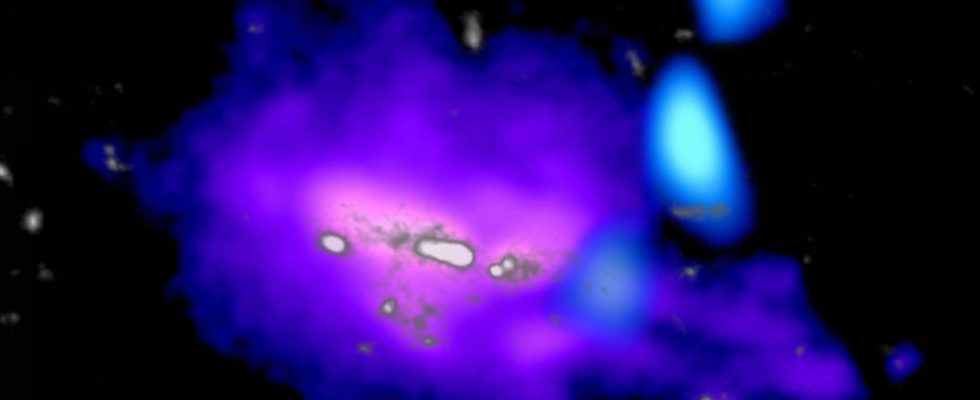Observations reveal the existence of intergalactic currents made of carbon. They wander through space until they reach a galaxy. A phenomenon that would have been crucial for the formation of the first stars at the beginning of the Universe.
In the galaxies are formed sets sometimes called star nurseries. These are dense areas, where gas collects to form protostellar cores which later give birth to stars.
Zooming out a bit, it is common to visualize these galaxies as compact sets where matter gathers or disperses in a constant dynamic. But galaxies are not only driven from within, they sometimes have a little help from outside.
This aid is at the heart of a study published in the journal Science on March 30. The authors detected an intergalactic current that transports gas to the galaxies. ” It’s a stream of cold gas heading towards a massive galaxy, summarizes for Numerama the main author, Bjorn Emonts. ” It provides raw material to form billions of new stars. »
A nurturing cosmic river
The astronomer from the National Radio Astronomy Observatory in Charlottesville, United States, used the ALMA telescope in Chile to locate this current. They targeted a massive galaxy poetically named 4C41.17, at a 3.8 redshift — meaning it was born 10 or 12 billion years ago, relatively soon after the Big Bang. The current was difficult to spot because it is not very dense, and extends over 100 kiloparsec, or more than 300,000 light years! Which is even bigger than the galaxy it’s heading towards.
Contrary to appearances, finding such a large set is rather difficult, because telescopes that look so far into the Universe tend to want to focus on a particular area in order to be able to observe all its characteristics. Here, it was rather necessary to use the lowest resolution to maximize the sensitivity of the telescope on a light emitted by a cold gas.
A method that has led to a result long predicted by simulations, but never demonstrated. ” Computer models predicted the existence of these currents, but this is the first time we’ve actually observed one. “says Bjorn Emonts. ” They are like rivers flowing into the ocean. But the few studies that found any focused on streams of hot gas, which is not suitable for forming stars. In this study, the current is described as formed by a large quantity of cold carbon dioxide: It’s a bit like a river, but this time transporting nutrients in its sediments! »
This discovery is crucial for understanding the formation of galaxies in the early Universe. Because we must remember that the image that we observe today of 4C41.17 comes to us from a distant past, more than 10 billion years ago, at a time when the Universe was very different from what it is today.
Essential hardware in a young Universe
A time when galaxies were not isolated islands from the rest of the Universe, but when outside influences were far greater than today. In other words, this current is not a bonus granted to the galaxy, but its main source of material to form stars according to Bjorn Emonts: ” We can estimate how much material the current is depositing in the galaxy, and it turns out that’s roughly equal to the number of stars being created there each year. So 4C41.17 needs this current to grow. Without this current, it would have become a graveyard of old stars in just 500 million years. Today, however, it is one of the largest galaxies of this era of the Universe.
A mechanism that is very different from that encountered by younger galaxies like our Milky Way. Here, the real source of growth is the amalgamation of smaller galaxies that form larger wholes. ” There is indeed the magellanic current “, adds Bjorn Emonts, “ but it’s completely different: it’s more about debris from smaller galaxies “.

The question that remains unanswered is: how could this cold gas have formed? A legitimate question since the theory is that after the Big Bang, the gas available in the cosmic web of the Universe, before the formation of galaxies, is very hot. And that it needs several billion years to cool down. A period of time to which this current was not entitled since it was formed only two billion years after the Big Bang, which is much too early.
In a perspective paper that accompanies the study, astronomer Caitlin Casey of the University of Texas, considers that this study is a big step forward in understanding the still poorly understood mechanisms of cold gas currents, but that it there is still a long way to go: This current is rich in carbon, but it is a heavy element that forms in stars. We therefore believe that he used recycled material to feed other galaxies. (…) Obtaining observations that match the predictions of the simulations was a long-term task. »
Fortunately, Bjorn Emonts’ study could be a decisive step. Now that the team has identified the right method to effectively detect one of these currents, it is likely that others will be unearthed. ” It will be difficult “, laments Bjorn Emonts. ” We think we can find others with ALMA, but as you have to do a “de-focus” to find them, you would need observations dedicated solely to that, which doesn’t happen often. »
Do you want to know everything about the mobility of tomorrow, from electric cars to pedelecs? Subscribe now to our Watt Else newsletter!
